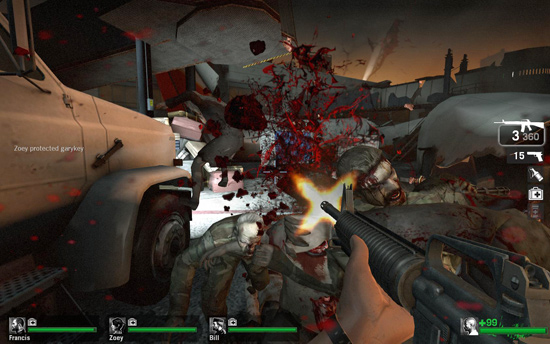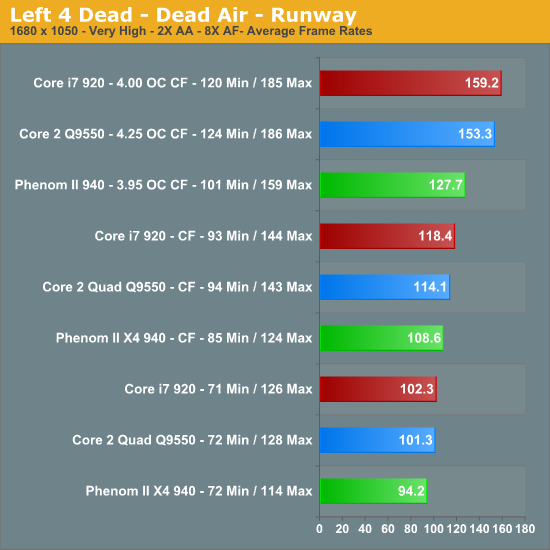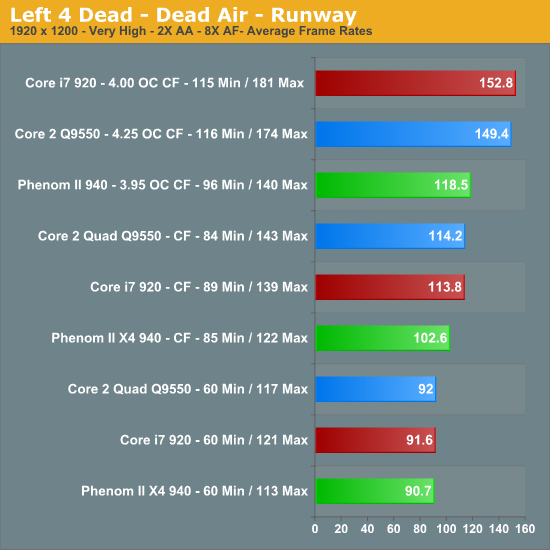CrossFireX and the Phenom II X4 940 – Competitive or Not?
by Gary Key on February 2, 2009 12:00 AM EST- Posted in
- Motherboards
Left 4 Dead

This game is a blast and addictive to boot - provided you like killing hundreds of zombies while trying to take care of your teammates and sustaining high blood pressure rates. What we really like about Source engine games is their ability to run well on variety of systems. We enable all options, set AA to 2x and AF to 8x, and play back a custom timedemo of a complete game session from the Runway chapter within the Dead Air campaign.

This title also favors the Intel platforms. When comparing the Q9550 to the Phenom II 940 at 1680x1050 it holds a 7% average frame rate advantage in single card mode, 5% in Crossfire, and 20% in the overclocked settings even though the Q9550 only has a 7% clock speed advantage. Minimum frame rates for the Phenom II remain very competitive against the Q9550 until the processors are overclocked, but a 101fps minimum is still outstanding. The i7 continues to dominate the other two solutions in benchmark results.
Adding a second card for CrossFire operation improves average frame rates by 15% and minimum frame rates by 18% for the Phenom II. The Intel Q9550 has an improvement of 13% in average frame rates and 30% in minimum frame rates. The Core i7 average frame rates improve by 16% and minimum rates increase 31%. Overclocking our processors resulted in an 17%~34% average improvement in average frame rates with the Core i7 benefiting the most.

No surprises here; the 1920x1200 results follow the pattern set at 1680x1050. All three solutions bunch together in the single card results and then spread out as we introduce CrossFire and overclocking into our equation. The Q9550 holds a 10% advantage over the Phenom II in CrossFire and 26% when overclocked. Minimum frame rates continue to be very good for the Phenom II in single card and CrossFire operation.
The Q9550 scores slightly better than the i7 in the single card and CrossFire mode as its 6% advantage in clock speeds (or perhaps the larger L2 cache) comes into play as we start to become more GPU limited at this resolution. The Phenom II has a 6% clock speed advantage over the Q9550 and a 12% advantage over the i7 that leads us to believe platform efficiency is a problem or the game engine optimizations favor Intel. We believe it is a combination of both.
Adding a second card for CrossFire operation improves average frame rates by 13% and minimum frame rates by 42% for the Phenom II. The Intel Q9550 has an improvement of 24% in average frame rates and 40% in minimum frame rates. The Core i7 average frame rates improve by 24% and minimum rates increase 48%. Overclocking our processors resulted in a 16%~34% average improvement in average frame rates with the Core i7 benefiting the greatest.
Our game play experiences revealed no differences between the three platforms. Although the frame rates were lower with the Phenom II, it just did not matter in this game as minimum frame rates were at 60fps or higher in our tests.










68 Comments
View All Comments
Joe Schmoe - Tuesday, February 3, 2009 - link
This was a very good article. I'm not quite ready to build a new system just yet. But it is tax return season. I'm glad the Phenom II is competitive. We all win when AMD puts out a nice chip. I was about to jump on the I7 band wagon but decided to just grab a q6600 and save my coins for now. Hopefully this will end some of the endless flame wars going on through the forums.
Aquineas - Tuesday, February 3, 2009 - link
First of all, thanks for the hard work you put into testing. Many folks are getting hung up on 5-10 percent performance differences and making a big deal out of it . I think the most important part of the article is the part where it says, repeatedly (paraphrased):"We couldn't perceive a difference in gaming performance between platforms."
That being said, I think 18 months from now we'll see more games where the CPU differential matters more, which is right around the time I'll be doing my next system build.
myterrybear - Tuesday, February 3, 2009 - link
I agree with this as well, great job on the article & shows the point as I have ALWAYS said, when it comes down to it would ya even notice the diffrence between the 2 if you had just sat down on it & started to do stuff on it ??Yeah exactly 6 or 8 gig ram on Phenom II would be interesting, I know I've found 4 gigs on Phenom I to be very nice now that I am running a full 64bit os ( win 7 beta) on a oc to 3 ghz Phenom 9850 be. I'm just awaiting to see how things will be once I get my Phenom II 940 any second now. :)
myterrybear - Tuesday, February 3, 2009 - link
My thing that I am noticing with all these tests of core i7 vs phenom II is the fact the systems are not even ramwise. I mean what would a core i7 run like with 4 gigs of ram or if the phenom II platform had 6 gigs of ram.it's a valid argument I think.
Aquineas - Tuesday, February 3, 2009 - link
Honestly, it probably wouldn't matter much. If I were the author I'd re-run the test with 8GB on the PII, but it's probably less than a 2 percent differential.BlueBlazer - Tuesday, February 3, 2009 - link
Love to see Intel and AMD in SLI numbers!ThePooBurner - Monday, February 2, 2009 - link
Am i the only one that noticed that the results for the PhenomII were just about identical between resolutions? There should have been some form of difference unless the AMD platform is being artificially hard-capped for some reason. Otherwise that the frame rates would be identical when upping the resolution makes no sense at all. I suggest looking into it further.ThePooBurner - Monday, February 2, 2009 - link
Err, Crysis Warhead is what i meant by FarCray2.7Enigma - Tuesday, February 3, 2009 - link
This is a perfect example of why the full data is so incredibly important in teasing out the details.Yes if you look at the graphs they show a very close clustering for the single card, CF, and overclocked CF, but if you look to the right of the names you will see the min and more importantly max will scale with upgraded components. Not to the same level as one would like but there appears to be some really REALLY rough sections as the min frame rate is almost identical across the board (look at single vs. CF you see the same frame rate). That is probably due to some driver issue where both cards are not being utilized and the single card is not optimized well either.
ThePooBurner - Wednesday, February 4, 2009 - link
I think you are missing my point. When going to a higher resolution it is expect that the frame rates for a card will change. Both the min and the max as well as the average. In almost every single game tested the values for the ATi cards at all resolutions are nearly identical. This smells very fishy to me and makes me think there is some sort of artificial limit being placed on the ATi hardware.